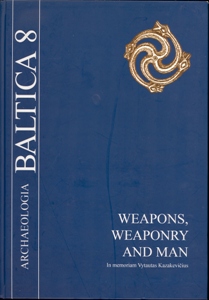Volume 8 (2007): Weapons, Weaponry and Man (In memoriam Vytautas Kazakevičius), November 2007

Order by:
Pub. online: 9 Nov 2007
Type: Article
 Open Access
Open Access
Journal:
Archaeologia Baltica
Volume 8 (2007): Weapons, Weaponry and Man (In memoriam Vytautas Kazakevičius), pp. 195–204
Abstract
Pub. online: 9 Nov 2007
Type: Article
 Open Access
Open Access
Journal:
Archaeologia Baltica
Volume 8 (2007): Weapons, Weaponry and Man (In memoriam Vytautas Kazakevičius), pp. 205–213
Abstract
Pub. online: 9 Nov 2007
Type: Article
 Open Access
Open Access
Journal:
Archaeologia Baltica
Volume 8 (2007): Weapons, Weaponry and Man (In memoriam Vytautas Kazakevičius), pp. 214–222
Abstract
Pub. online: 9 Nov 2007
Type: Article
 Open Access
Open Access
Journal:
Archaeologia Baltica
Volume 8 (2007): Weapons, Weaponry and Man (In memoriam Vytautas Kazakevičius), pp. 223–230
Abstract
Pub. online: 9 Nov 2007
Type: Article
 Open Access
Open Access
Journal:
Archaeologia Baltica
Volume 8 (2007): Weapons, Weaponry and Man (In memoriam Vytautas Kazakevičius), pp. 231–237
Abstract
Pub. online: 9 Nov 2007
Type: Article
 Open Access
Open Access
Journal:
Archaeologia Baltica
Volume 8 (2007): Weapons, Weaponry and Man (In memoriam Vytautas Kazakevičius), pp. 238–253
Abstract
Pub. online: 9 Nov 2007
Type: Article
 Open Access
Open Access
Journal:
Archaeologia Baltica
Volume 8 (2007): Weapons, Weaponry and Man (In memoriam Vytautas Kazakevičius), pp. 254–262
Abstract
Pub. online: 9 Nov 2007
Type: Article
 Open Access
Open Access
Journal:
Archaeologia Baltica
Volume 8 (2007): Weapons, Weaponry and Man (In memoriam Vytautas Kazakevičius), pp. 263–272
Abstract
Pub. online: 9 Nov 2007
Type: Article
 Open Access
Open Access
Journal:
Archaeologia Baltica
Volume 8 (2007): Weapons, Weaponry and Man (In memoriam Vytautas Kazakevičius), pp. 273–282
Abstract
Pub. online: 9 Nov 2007
Type: Article
 Open Access
Open Access
Journal:
Archaeologia Baltica
Volume 8 (2007): Weapons, Weaponry and Man (In memoriam Vytautas Kazakevičius), pp. 283–291
Abstract